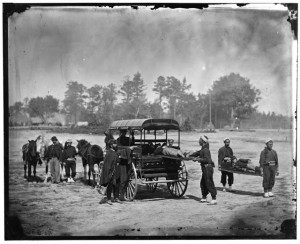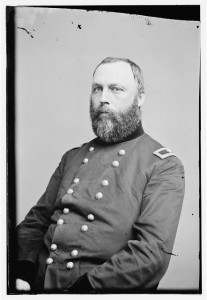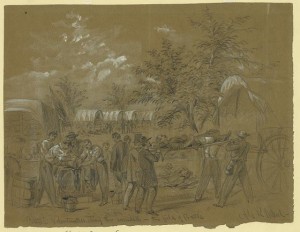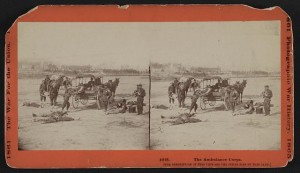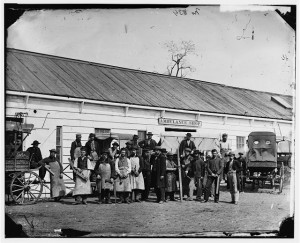According to Civil War Home, in August 1862 General McClellan ordered the creation of a more professional ambulance corps for the Army of the Potomac under the supervision of the army’s medical director. Apparently the results were still not too good. Here are some excerpts from an editorial arguing for the creation of an ambulance corps under the direction of the Surgeon General.
From The New-York Times October 10, 1862:
An Ambulance Corps.
We have every reason to expect that the hardest fighting of the war will occur within the ensuing ninety days. We sometimes talk of a million of men in arms, and of the movements of such columns as have never before been seen in hostile array, as though so many complicated masses of inanimate machinery were about to be brought into collision, to settle some mooted question of physical force, merely. How many of us attempt to estimate the amount of human suffering that must ensue? How many realize the fact that in less than ninety days from this time sixty or seventy thousand of our friends and brethren may be stricken down in battle — thousands to find soldiers’ graves, and more, by their wounds and sufferings, to become the objects of an anxiety and solicitude which shall sadden thousands of households. When our relatives are about to go forth to the fight, we are clamorous in our demands that they shall be armed and equipped with all the appliances of sturdy soldiers. Government gathers its stores of food, clothing and ammunition, and distributes them by the usual avenue. Hospitals are erected at points more or less remote from the scenes of probable conflict in obedience to the dictates of sanitary science, and thousands of medical men are drawn from the pursuits of peaceful practice to contribute their skill upon the battle-field.
Now, what does all this mean, unless it be to put our brave soldiers in fighting trim and to provide for them when they fall at the post of duty? …
We hear a good deal from very high sources about discouraging enlistments, and all good citizens acquiesce in the exercise of the War Power to prevent such treasonable operations; but if the scenes of the second Bull Run and Antietam battle-fields are reenacted, verily an outburst of popular indignation, taking its keynote from the unavailing groans of the wounded and dying, will do more to discourage enlistments in one moment, than substitute associations and the schemes of rebel sympathizers could in forty years. The wounded must be cared for, — the Surgeon-General has indicated how it may be done by the organization of an Ambulance and Field Hospital Corps.
The Sanitary Commission has written, talked and worked for a similar plan for more than a year. The argument brought against the plan, that it will add to the already monstrous transportation of the army, is devoid of foundation. …
It is preposterous, it is criminal, to deny to the Medical corps a sufficient number of vehicles to insure the transportation of the means for saving life and alleviating suffering. It is cruel and barbarous to deny to the wounded the means of conveyance from where they fell like heroes to where they can be treated like Christians. For nearly a week the wounded lay upon the second Bull Run field, starving and dying, awaiting the arrival of ambulance trains, and when they came they were made up of hacks, omnibuses and ambulance wagons, manned by men and boys, all of whom were ignorant of the first principles of the ambulance practice, and many utterly inhuman, and not a few drunk.
After Antietam, nine or ten thousand wounded men lay for days, mostly unsheltered, in the open air, awaiting the arrival of aid and comfort, ministered to by surgeons not one of whom would have had the appliances most essential to their art and efficiency if it had not been for the Sanitary Commission. Life was lost that might have been saved, and yet no blame must attach to the Medical Bureau. Without an ambulance corps, it cannot perform its high functions. You might as well expect a crowd of eager miners, with their bare hands and no tools, to penetrate the beds of an exploded coal mine in search of dying comrades, as to expect surgeons to meet the demands of suffering upon the battlefield without the facilities of an organized ambulance corps.
The corps should consist of picked men, drilled for the work and officered by medical men. Instead of being an incumbrance to the army, it would not only return to the ranks ten or twelve thousand men, who now, in response to the dictates of humanity, or upon pretence of helping a stricken comrade, straggle to the rear, but relieve our commanders from a vast deal of the irregular but otherwise necessary assistance of an endless number of volunteer and temporary helpers. Such a corps could carry shelter, food, stimulants and surgical appliances, and answer at once the cry for help which now arises in piteous accents from every new battle-ground.
The following letter from the Surgeon General also appears at Civil War Home:
SURGEON-GENERAL’S OFFICE,
September 7,1862.
HON. EDWIN M. STANTON,
Secretary of War.
SIR : I have the honor to ask your attention to the frightful state of disorder existing in the arrangement for removing the wounded from the field of battle. The scarcity of ambulances, the want of organization, the drunkenness and incompetency of the drivers, the total absence of ambulance attendants are now working their legitimate results-results which I feel I have no right to keep from the knowledge of the department. The whole system should be under the charge of the Medical Department. An ambulance corps should be organized and set in instant operation. . . . Up to this date six hundred wounded still remain on the battlefield, in consequence of an insufficiency of ambulances and the want of a proper system for regulating their removal in the Army of Virginia. Many have died of starvation ; many more will die in consequence of exhaustion, and all have endured torments which might have been avoided. I ask, sir, that you will give me your aid in this matter ; that you will interpose to prevent a recurrence of such consequences as have followed the recent battle-consequences which will inevitably ensue on the next important engagement if nothing is done to obviate them.
I am, sir, very respectfully, your obedient servant,
WILLIAM A. HAMMOND,
Surgeon-General.
William Alexander Hammond served as Surgeon General from 1862-1864. Union field commanders gradually improved the quality of the ambulance services under their supervision. Congress acted to officially establish an ambulance corp in March 1864.

